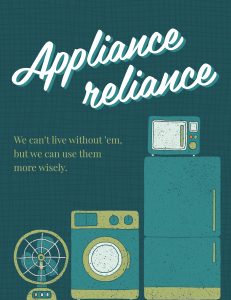 Where would you be without those time- and labor-saving appliances in your kitchen and laundry room? You’d probably be right there in the kitchen and laundry room a lot longer than you are now, tackling chores the hard way like folks did before electricity. And that’s certainly not practical, considering today’s hectic lifestyles!
Where would you be without those time- and labor-saving appliances in your kitchen and laundry room? You’d probably be right there in the kitchen and laundry room a lot longer than you are now, tackling chores the hard way like folks did before electricity. And that’s certainly not practical, considering today’s hectic lifestyles!
Those appliances — like refrigerators, ranges, dishwashers and clothes washers and dryers — account for about 13 percent of your home’s energy costs. It makes sense — and cents — to get the most out of those appliances and to save energy whenever possible.
The next time you go appliance shopping, consider the two price tags you’ll be facing. The first accounts for the appliance’s purchase price. Think of it as a down payment. The second price tag is for what you’ll have to pay on your electric bill to operate the appliance throughout its lifetime.
When you consider that second price tag, you realize how important it is to purchase energy-efficient appliances. That’s why you want to pay attention to the bright yellow EnergyGuide on the appliance when you go shopping. Read the label to find out the appliance’s annual energy consumption and operating cost. Consider this information when deciding which appliance to buy. In the long run, what you think is a bargain may really not be.
Also when shopping, look for the blue ENERGY STAR label. ENERGY STAR products exceed the federal minimum standards for efficiency and quality.
How to read the EnergyGuide label
The label provides information about energy consumption and shows you how much energy an appliance uses compared with similar models. Keep in mind that the numbers are averages; actual costs may differ depending on how you use the appliances.
Information on the label:
- Maker, model number and size of the appliance
- Estimated yearly operating cost (based on the national average cost of electricity), and the range of operating costs for similar models.
- The ENERGY STAR logo on the label shows that the model meets strict criteria for energy efficiency.
- Estimated yearly electricity consumption.
- Key features of the appliance and the similar models that make up the cost comparison range.
Wise energy use will save you money
Here are some easy tips to help you save energy and money in the kitchen and laundry room.
- Be sure your dishwasher is full — but not overloaded — when you run it.
- Scrape, but don’t rinse, food residue that’s especially messy off dishes before loading the dishwasher. No need to soak or pre-wash dishes and pans unless there is burned or dried-up food on them.
- Let your dishes air dry.
- Your refrigerator and freezer should keep your food cold — but don’t set the temperature too low. The recommended temperature for the fresh food compartment is 37-40 F. For the freezer, it’s 5 F. To calculate the temperature in your refrigerator, place an appliance thermometer in a glass of water in the center of the fridge. After 24 hours you can look to see what the thermometer says. Find out your freezer’s temperature by placing the appliance thermometer between frozen packages in the freezer. Again, read the thermometer after 24 hours.
- Refrigerator door seals should be airtight. To test the seal, close the door over a piece of paper making sure it is half in, half out, of the door. Can you pull the paper out easily? If so, the latch may need to be adjusted, the seal may need to be replaced, or you may need a new refrigerator.
- Don’t store uncovered or unwrapped foods in the fridge. Not only is it unsanitary — the food will release moisture that can make your compressor work harder.
- When using your stove’s range, match the size of the pan to the heating element.
- Cooking for one or two? Use small electric pans, toaster ovens and convection ovens instead of your stove or oven to save as much as one-third to one-half of the energy you’d use with your full-sized oven.
- Pressure cookers and microwave ovens are also convenient energy savers — and time savers.
- Unless you’re tackling oily stains on your clothes, wash them in cold water using cold-water detergents.
- Try to wash and dry full laundry loads. If you have to wash a small load, use the appropriate water-level setting.
- Speed up the drying process by drying towels and heavier cotton items separately from lighter-weight items.
- Make it a habit to check and clean your dryer’s lint screen as you’re unloading the dryer. This improves air circulation and helps prevent fires.
- Use your dryer’s cool down cycle. Your clothes can finish drying with the heat that remains in the dryer.
- Remember to periodically check your dryer vent to make sure it is not blocked. A clear vent will save you energy and reduce fire risks. Vents should be made from a rigid material, not plastic. Plastic vents can collapse, resulting in blockages.
Easy ways to save energy in other rooms of your house
- Install a programmable thermostat to manage heating and cooling systems efficiently.
- Turn things like lights, TVs, entertainment systems and your computer and monitor off when you are not in the room or are not using them.
- Plug home electronics like TVs and DVD players into power strips. Turn the power strips off when the equipment is not being used. TVs and DVD players in standby mode still use several watts of power.
- Lower your water heater’s thermostat to 120 F.
- Take short showers instead of baths. Use low-flow showerheads.
- Ensure that windows and doors are closed when heating or cooling your home.



